|
Lieutenant Raymond Carl Zettel made three visits to Tucson, one as pilot in command and the other two as a passenger. His first landing was on Saturday, 3/13/1926. He was one of four passengers flying with Lt. W.S. Navely in the Douglas C-1 transport they identified as 25-429. Based at San Antonio, TX Kelly Field, they arrived eastbound from San Diego, CA Rockwell Field to an unidentified destination. One fellow passenger was Regsiter pilot Harry Weddington.
His second landing was on Monday, March 22, 1926. Based at Kelly Field, he was piloting a Douglas O-2, number 25-373, arriving from Rockwell Field, San Diego, CA at 2:00PM and departing at 3:00 PM for El Paso, TX. One of the earliest signers of the Register (he was pilot number 123 of 3,704 signatures), Lt. Zettel was, by 1926, a very experienced flier. Below is a classic oil portrait of Zettel, courtesy of his daughter and son-in-law.
Ca. 1963 Painting Commissioned by USAF to Commemorate Naming of the High School Gymnasium at Clark Field (Source: Zettel Family Album)
 |
First Lieutenant Raymond Carl Zettel, Date Unknown (Source: Zettel Family Album)
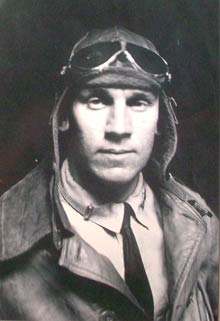 |
His third visit was on Friday, March 14, 1930. He was the sole passenger with Lt. J.G. Taylor, flying in an unidentified Douglas O-32. Based at Dayton, OH Wright Field, they arrived from El Paso, TX westbound to Los Angeles, CA. They remained overnight in Tucson.
Entering the Army as a private, Zettel was assigned to the aviation section of the Army Signal Corps on December 29, 1917. He was commissioned as a second lieutenant in the Air Service in 1918, and received his final rank of first lieutenant in 1920. His ratings included Air Pilot and Air Observer.
A native of West Branch, Michigan, he was born on March 6, 1894 to Emma and Christian Zettel. In 1919 he married Janice Morrison; they had two children, Raymond Jr. and Alice. Raymond Jr., a West Point graduate, was killed in 1943 while flying a P-47 (see below). Daughter Alice is now Alice Z. Vanest, living in the Chicago area with her husband Joe, who has provided much of the photographic and biographic information for this page. Zettel’s brother, Clyde, served alongside Raymond in WWI as a medic. At left, Zettel appears in classic helmet and goggles.
During WWI, Lt. Zettel served as a pursuit and observation pilot in France and Germany, and later served in the army of occupation in Europe. Upon returning to the U.S., he saw duty as an observer pilot on the Mexican border. Below, a photograph of Zettel with a fleet of period aircraft.
Raymond C. Zettel Standing Next to SPAD, Ca. 1918 (Source: Zettel Family Album)
 |
Based at Kelly Field, TX in 1925, he participated in a low-level bombing practice at Langley Field, VA. Flying de Havilland airplanes, he and Register pilot teammate Hoyt S. Vandenberg (a future USAF chief) placed fourth in the competition. The San Antonio (TX) Express, Saturday, November 7, 1925 reported the practice activity as follows. Note the plethora of other Register pilots participating in the practice, and the author's editorial pressure for better, more modern aircraft for the Army.
KELLY FIELD BOMBERS' SHOWING IN VIRGINIA
All the country will note the excellent work of Kelly Field pilots in the low altitude bombing practice at Langley Field (Virginia). First honors went to Lieut. Harrison G. Crocker of the 3d Attack Group, who scored 115 points; [Register pilot] Lieut. Franklin O. Carroll, his gunner, took part in the machinegun tests and achieved a splendid record. Notwithstanding the fact that Kelly Field teams had to fly De Haviland [sic] planes, which are considered out-of-date, they gained first and fourth places. Some had expected that one of the fast Curtiss pursuit planes from Selfridge Field (Michigan) would carry the winners. [Register pilot and charter member of the Daedalians] Lieut. Warren R. Carter of France Field (Canal Zone) took second place with a De Havilland; [Register pilot] Lieut. Charles Douglas of the 1st Pursuit Group was third; Lieutenants Hoyt S. Vandenberg and Raymond C. Zettel the fourth team in the results.
The bombing tests in which the Kelly Field teams participated are particularly interesting. In Europe there is much speculation as to the use of bombers against such foes as the French and the Spanish encounter in Morocco, and every report on the subject is scanned carefully. The Moroccan war zone offers almost unique advantages for ground forces operating against planes, however; the country is unusually rugged and contains many caves and nooks which form natural dugouts. Weather conditions also are adverse most of the year; hot winds from the Sahara Desert often sweep over the region in the dry season, and fogs and heavy rains characterize the fall and winter months. French and Spanish aviators therefore have devoted more time to bombing such places as Sheshuan and Adjir— headquarters for enemy staffs—and they assert that results have been satisfactory considering the handicaps.
In Syria the French have employed planes against the Arab and Druse lines, as I well as to bomb positions; but political reasons have kept both the French and the Spanish from fully utilizing their aircraft, as they would rather restore peace through negotiation. Bombing operations in those regions will be studied carefully in all countries that maintain aviation establishments. Our Army Air Service pilots have developed accuracy with both demolition and fragmentation bombs; the former are used against targets representing fortifications and similar objectives, and the latter against those which outline troops and field material. Fragmentation bombs generally are dropped from comparatively low altitudes while machinegun fire is directed on the objective. The methods developed at Kelly Field evidently are equal to those of any foreign aviation school, but the Air Service should have later types than the De Havilland and the Martin Bomber. Of course, skill and experience count for much—as at Langley Field recently— but the pilots deserve better ships than those which most of them must fly. Both their records and more consideration for safety entitle them to receive the improved equipment.
|
After a tour of duty at Wright Field, Dayton, OH, where Zettel participated in low-level bomb development testing, he was assigned to the Philippines, where he flew Keystone B-3 bombers. Below, a photograph of Zettel in the Philippines, hatless in the bottom row.
Raymond C. Zettel (Second from Right, Bottom Row) - Philippines Ca. 1930 (Source; Zettel Family Album)
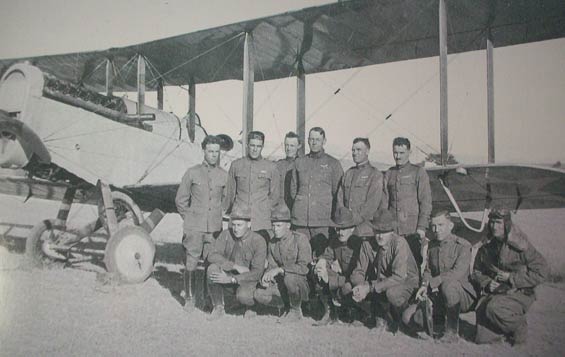 |
First Lt. Raymond C. Zettel Sr. Ca. 1932 (Source: Web via Woodling)
 |
The New York Times, January 16, 1931 (Source: Woodling)
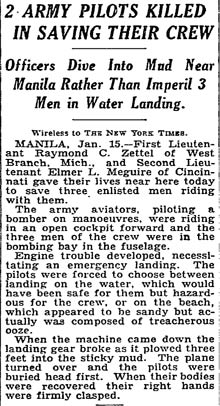 |
On January 15, 1932, Lt. Zettel, copilot Elmer Meguire, and three other crew members, were flying a B-3A, number 30-286, near Manila when engine trouble forced them quickly to look for a safe place to land. They chose what looked like a sandy beach but it was composed of mostly soft mud. The landing gear sheared off on landing and the airplane nosed over, trapping and asphyxiating Zettel and Meguire deep in the ooze.
Their accident was documented in The New York Times of January 16, 1932, left. The three crew members survived.
Copilot Meguire was a graduate of the U.S. Military Academy (USMA) at West Point, NY. His senior portrait and description are below, right from the USMA yearbook of 1930.
Second Lieutenant Elmer Landon Meguire, 1930, Zettel’s Copilot (Source: Woodling)
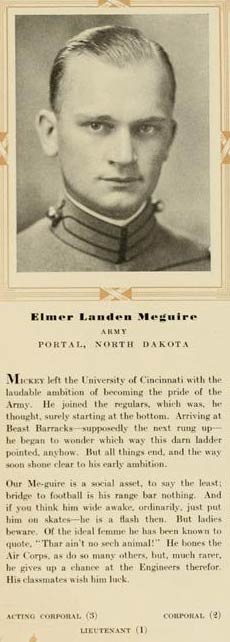 |
According to site visitor Roger Holden, the plane they were killed in would have belonged to the 28th Bomb Squadron (the only Keystone squadron in the Philippines.) The San Diego Aerospace Museum ISDAM) photostream contains numerous photographs of the Squadron's aircraft, the ones at the link being some of them. Note the distinguishing white diamond squadron insignia on the nose, which contained a Mohawk indian's head. None of their identifying numbers can be read, so it is not clear if any of them was 30-268. Below, one of the 28th Bomb Squadron Keystones from the SDAM photostream.
28th Bomb Squadron Keystone Bomber (Source: SDAM)
 |
Below, left, is Zettel's obituary from the Gladwin County (MI) Record of April 14, 1932.
LT. RAYMOND C. ZETTEL
GIVEN FINAL RITES AND HONORS THURSDAY AT WEST BRANCH
The body of Lieut. Raymond C. Zettel, who was asphyxiated Jan. 15, 1932, while piloting a bombing plane which crashed in a forced landing in a muddy bog, arrived Wednesday, April 6, at West Branch, where his family and relatives have been awaiting its arrival since January.
Services were held the next day, Thursday, April 7, at 9:30 a.m. at the church of St. Joseph, Rev. Father Miller of West Branch, Rev. Father Webler of Bay City and Rev. Father Patrick Dunniagan of Flint, of the American Legion, officiating, the latter giving the address.
Ceremonies were in charge of the West Branch American Legion post, which was represented by 40 legionnaires. William Schwab, aviator of Bay City, paid an aerial tribute piloting his plane over the city during services and burial. Business places at West Branch were closed from 9 a.m. to 11 a.m.
Lieutenant Zettel had been in the United States air service since 1917, and about two years ago was transferred to the Philippines. He is survived by his wife and two children; his mother, Mrs. John Rau; and sister, Mrs. D. E. Tolfree, all of West Branch; and brother, Clyde L. Zettel, of Gladwin.
|
First Lt. Raymond C. Zettel Jr. Ca. 1943 (Source: Web via Woodling)
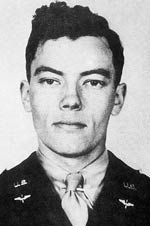 |
Several memorials were established in Lt. Zettel’s name. A US Army airfield at Jolo on the island of Sulu was named Zettel Field. A grass strip at the time, the airfield has now been paved with a runway suitable for jet airliners. Two memorials were established at Clark Field near Manila: the gymnasium at Wagner High School was named in honor of both Raymond C. Zettel and his son, Raymond Jr., left. Young Zettel was killed June 29, 1943 when his Republic P-47C crashed five miles northwest of Saluda, VA. His airplane collided with trees while he was trying to fly under a 300-foot ceiling at an estimated speed of 200 MPH. He was on a ferry flight with his new airplane from Middletown, PA to Langley Field, VA.
CLARK AB, P.I. (Ol)--Ceremonies officially naming the Wagner High School and Zettel Gymnasium here will be held Oct.1, with a flyover followed by an open house and tour of the new buildings. The flyover and the unveiling of portraits of the three men for whom the buildings are being named will he held at 10 a.m. in the school and refreshments will be served later during the open house. The school was named for Lt. Col. Boyd D. Buzz Wagner, the first ace of World War II, who was stationed at Clark during the early part of the war.
The gymnasium was named for 1st Lt. Raymond C. Zettel Sr., a World War I pilot who died in an airplane crash near Malabon, P.I. in 1932 and his son, 1st Lt. Raymond C. Zettel Jr., who was killed in an aircraft mishap near Saluda, Va., in 1943. Maj. Gen. Theodore R. Milton, Thirteenth Air Force commander; Col. R. C. Crawford Jr., 405th Fighter Wing commander and Col. Vernon W. Froehlich, Clark AB commander are scheduled to attend the ceremonies with some 500 school children and military personnel.
|
At right, from the Pacific Stars and Stripes of September 26, 1962 is an article describing the dedication cited above.
While not specifically named after Lt. Zettel, the airport at Gladwin, Michigan is known today as “Gladwin Zettel Memorial Airport.” It is named for Raymond’s nephew, Charles Zettel, who for many years served on the airport development board. However, the original Gladwin airport does have an historical connection to Lt. R.C. Zettel, Sr., who first reported the characteristics of the field to the Air Service on October 27, 1924.
The two pages shown below describe the airport as it existed in 1925 and record Lt. Zettel's report.
Aeronautical Bulletin, May 1, 1925, Gladwin Emergency Field (Source: Zettel Family Album)
 |
The fact that airports seem ALWAYS to be built near high tension wires has been a part of pilot lore and hangar discussions for decades.
Aeronautical Bulletin, May 1, 1925, Gladwin Emergency Field (Source: Zettel Family Album)
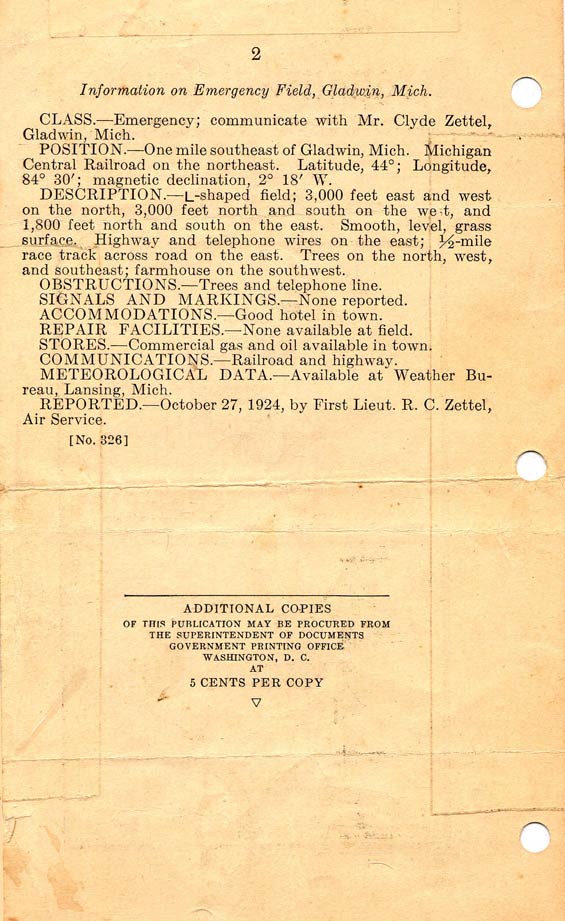 |
---o0o---
THIS PAGE UPLOADED: 04/26/12 REVISED: 05/10/12, 06/22/12
|












